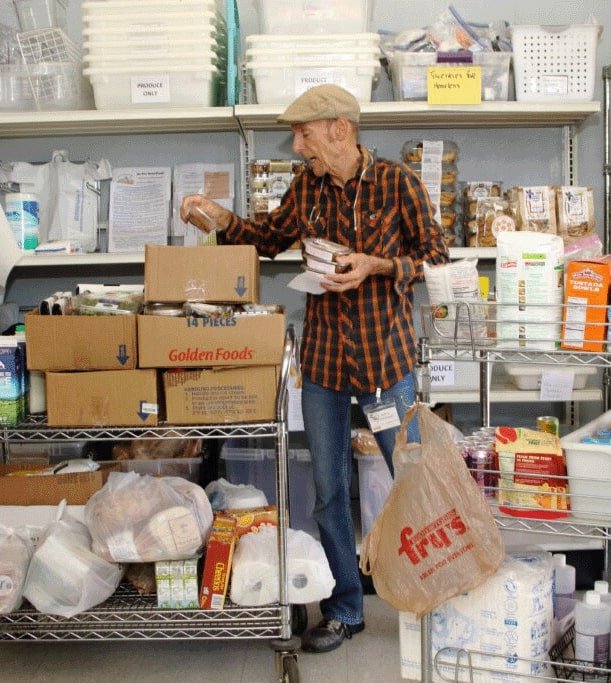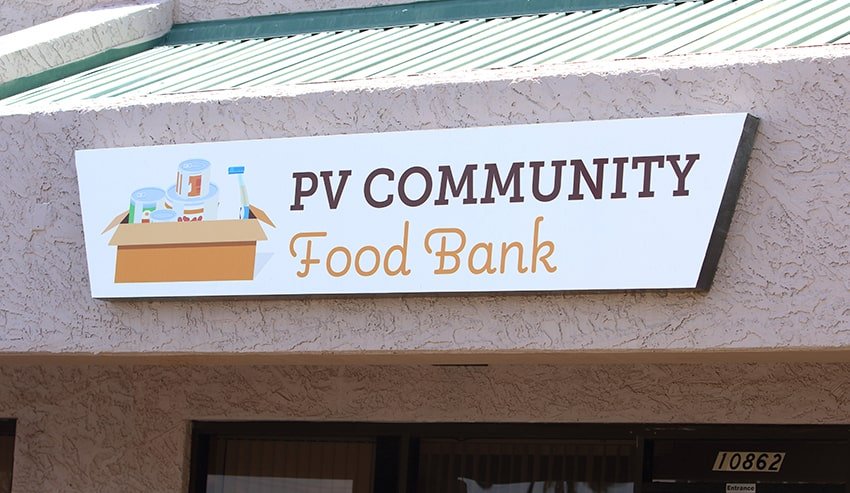
Our History
In 1986...
…a few community members started collecting food in their garages, so they could deliver emergency food supplies to struggling families in Northeast Phoenix.
From this humble beginning, the PV Emergency Food Bank was born.
Last year, this all-volunteer organization provided food assistance to over 1,500 individuals and families living within the geographic boundaries of the Paradise Valley Unified School District.
Hunger Crisis Strikes Northeast Phoenix
For many years, religious organizations in Northeast Phoenix took on the responsibility of feeding the hungry in their community. However, in early 1986, they noticed a sharp increase in food requests from people in their neighborhood.
With their food supplies starting to dwindle, local churches reached out to the Greater Paradise Valley Community Council for help. The Council was made up of civic-minded local residents focused on improving the quality of life in the area.
In March 1986, the Council responded by forming a committee to investigate the hunger problem in their community. After surveying nearby churches and schools, they discovered an urgent need for food among Northeast Phoenix residents.
At that time, 16 percent of children in the Paradise Valley Unified School District were receiving free or reduced lunches — a number that was higher than the state average. At Palomino Elementary School, located in the lowest income area of Northeast Phoenix, an estimated 68 percent of students received school meal assistance.
Community Members Take Action
In April 1986, under the leadership of Dr. Karen Kenyon, the Council formed the Greater Paradise Valley Community Assistance Team, or GPVCAT, with the goal of providing emergency food supplies to needy families within the PV Unified School District boundaries. They established a board of directors with members representing a diverse number of local businesses, charities and religious organizations.
GPVCAT chose not to accept any government funding. Instead, they worked strictly as a community organization taking care of its own people. They saw their role as an emergency food provider, and the question they asked daily was, “How can we get food on people’s tables tonight?”
Lacking any storage space, community members began collecting food in their garages and used their own personal vehicles to make deliveries to struggling individuals and families.
GPVCAT applied for non-profit status and received approval by the IRS to do business as a 501(c)(3) non-profit organization, enabling them to receive tax-deductible donations. By early 1987, area schools and businesses started holding food drives and charity events to collect food and cash donations.
Business and Religious Institutions Offer Critical Support
With no real place to call home, GPVCAT looked for creative ways to serve the hungry. Local businesses and religious institutions opened up vacant space in their buildings and campuses for volunteers.
The Paradise Valley Community Church provided a small bunkhouse to serve as a temporary “office” for the newly formed food bank. When this space was no longer available, Phoenix City Councilman Dr. Bill Parks shared his mobile home office with volunteers, so they could make phone calls and coordinate deliveries.
Westcor Partners, a shopping mall developer, donated space across the street from Paradise Valley Mall, which became a temporary warehouse for the food bank.
When local churches, synagogues and charities received food requests from the people in their community, they shared this information with the food bank. Volunteers would travel back and forth from the makeshift office and warehouse to fill orders and deliver food boxes directly to the homes of the needy that lived within the boundaries of the PV Unified School District.
Having the volunteer office and warehouse a few miles apart created logistical problems and delays in serving the needy. The food bank’s goal was to find a permanent facility that would allow the warehouse and office headquarters to operate under one roof.
In 1988, volunteers received an unexpected gift from a local business. In a continuing spirit of generosity, Westcor Partners offered the food bank a 900 sq. ft. space in the Shea Plaza on 32nd St. in Phoenix that could now house the food bank’s entire operation.
Volunteers were thrilled to move their operations out of their residential garages, as well as the makeshift offices and warehouses scattered throughout the community. As landlord of this commercial space, Westcor waived rental payments during the eight years it owned the Shea Plaza property.
Food Bank Streamlines Operations
In 1989, volunteer Irene Millstein became the first official director of the food bank. Irene and all her volunteers worked without any compensation and lived by the motto, Neighbors Caring, Neighbors Sharing.
In March 1990, GPVCAT began doing business as the Paradise Valley Emergency Food Bank to better reflect its mission.
With the growing demand for food, volunteers decided to have people pick up their food boxes at the food bank, instead of delivering food directly to their homes. Each food box contained a week’s supply of nutritionally balanced food. They also received some essential non-food items such as soap, diapers and pet food.
In October 1996, the food bank signed a lease with the new landlord of the Shea Plaza and began paying rent for the first time. When a neighboring business vacated its space within the shopping plaza, the food bank moved over to the larger 1500 sq. foot space. Not long after, the adjacent suite opened up and the food bank increased its space to 2500 sq. ft.
In 2002, Irene Millstein passed away suddenly. As founding director, she had devoted 13 years of service to the food bank. Volunteer Gail Marks, who Irene had mentored, became the new food bank executive director.
Weekend Food4Kids Backpack Program Feeds Hungry Students
From the very beginning, the food bank’s main focus was keeping children in the community healthy and well-fed. In 2006, the food bank joined forces with the PV Unified School District to launch a new program for Title 1 School students who were going hungry on weekends.
Although these children received free meals during the school week, they had little or no food support on the weekend and often arrived at school on Monday feeling lethargic and unable to focus on learning.
In partnership with the school district, the food bank began distributing nutritious, kid-friendly meals and snacks to the students on Friday, so they could stay well-nourished over the weekend and return to school on Monday ready to learn.
With the addition of this vital program, the food bank once again outgrew its space. When an adjacent suite opened up, it expanded its operations to its current 3800 sq. ft. space.
Food Bank Fueled by Strong Growth and Leadership
The number of requests for food boxes and Weekend Food4Kids Backpack food packs fluctuated from year to year, but the overall trend was one of growth and expansion.
In March 2020, Gail Marks retired from her position as executive director, after 18 years of dedicated service. Gail, along with her husband and three children, worked tirelessly to keep the food bank running smoothly for nearly two decades.
Kay Norris assumed the position of interim director of the food bank. As a longtime food bank volunteer, she brought valuable experience to the job, including her role as food bank facility manager and co-chairperson of the board of directors.
Volunteers and Donors Are Lifeblood of Food Bank
The number of requests for food boxes and Weekend Food4Kids Backpack food packs fluctuated from year to year, but the overall trend was one of growth and expansion.
In March 2020, Gail Marks retired from her position as executive director, after 18 years of dedicated service. Gail, along with her husband and three children, worked tirelessly to keep the food bank running smoothly for nearly two decades.
Kay Norris assumed the position of interim director of the food bank. As a longtime food bank volunteer, she brought valuable experience to the job, including her role as food bank facility manager and co-chairperson of the board of directors.
Community Spirit is Driving Force
Since its founding in 1986, the food bank has relied primarily on cash and food donations from individuals and businesses, with no government funding accepted, and it continues this tradition to this day.
The PV Community Food Bank has undergone many changes throughout the years, but its mission remains the same — to feed the hungry in Northeast Phoenix. None of this would be possible without its hard-working volunteers and the continued support of local businesses, charities and religious organizations that have partnered with the food bank from the very beginning.








